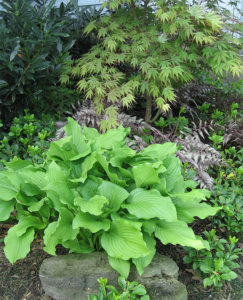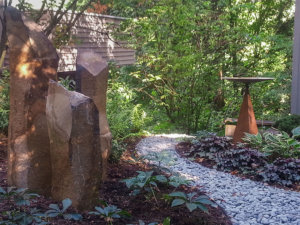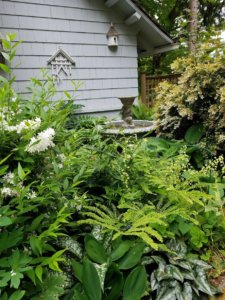
Hosta, Japanese Ghost Fern, Japanese Maple and Pachysandra are classic shade garden plants. This planting combination is from my front yard garden.
Shade Shade Baby
When I first began my career as a landscape designer I lived in Williamsburg, VA, where the summers are long, hot and humid. That is where I fell in love with shade gardens as restful and soothing antidotes to the extreme heat and bright sun.
Here in Portland and the Pacific Northwest, our normally temperate summers are becoming hotter and dryer, sparking not just wildfires but a growing need for more cooling shade in the urban landscape.
In my landscape design practice, I’m a big proponent of adding small deciduous trees (under 18’) to sunny landscape borders to create pockets of shade that will expand over time as the tree grows.
Layers are an important element in all gardens, so if a landscape is already shaded by large treesI like to add small understory trees (Dogwoods, Japanese Maples, Redbuds, Vine Maples) to create a mid-level layer between the large tree canopy and the smaller shrubs, perennials and groundcovers.
Shade gardening is an art form all its own, but here’s few basic rules to help you create your own shady garden. For help in selecting small trees, see the Bonus Feature, “Top Ten Small Trees” below.
Five Landscape Design Rules for Shade Gardens
Light: Shade plants tolerate different levels of shade, so. Your garden might feature a variety of shade types, including light shade, filtered light, bright light, dappled shade, partial shade and dense shade. Since not all shade plants are created equal, it’s essential to observe the natural light throughout the day and plant the right plant in the right place. You also must think about your garden’s water conditions, as shade plants have differing water needs just like sun loving plants.
Design: Think of your shade garden like a painting…use plants with variegated foliage or light blooms to highlight darker areas, or mass delicate ferns for an impressionist feel. Since nature is the best designer, take a walk in the woods and observe how native woodland plants grow. Do they create a mass by colonizing a stream bank? Do their forms and textures compliment or contrast with their neighbors? Take your cues from nature and you can’t go wrong.
Foliage: Shade gardens are wonderful for experimenting with bold foliage combinations. This is the place for variegated plants to add light to darker spaces, and for interesting leaf structures. Continuing with the analogy of your garden as a painting, consider plants with white or cream variegations as highlights in the garden.
Levels: Shade loving and woodland plants might not be as showy as their sun loving cousins, but their beauty lays their textures, leaves, stems, flowers and structure. A natural shade garden replicates a forest ecosystem, with three distinct plant levels. At ground level are the groundcovers and short plants, at mid-level are medium to tall shrubs and small trees, and at the canopy level are large deciduous and evergreen trees.
Soil: And last, but never least, the soil requirements of shade plants are dependent on what is planted around them. Trees are nutrient hogs, so testing and proper amending is crucial to shade plant health and longevity if you are planting in an area with mature trees.
There are many excellent shade gardening reference books, but here are a few that I treasure, chock full of gorgeous photos, insightful thoughts, and practical guidance.
Recommended Shade Garden Books
The New Shade Garden: Creating a Lush Oasis in the Age of Climate Change by Ken Druse
Taylor’s Guide to Shade Gardening: More Than 350 Trees, Shrubs, and Flowers That Thrive Under Difficult Conditions, Illustrated with Color Photographs and Detailed Drawings (Taylor’s Guides) by Frances Tenenbaum and Steve Buchanan
Shade: Ideas and Inspiration for Shady Gardens by Keith Wiley
- Striking foliage combinations are key elements of a shade garden.
- In areas where plants aren’t suited, adding features like these standing stones and the birdbath are easy solutions. Design by Harmony Design Northwest.
- White blooming plants and a variety of foliage textures make great choices in this client’s “Fairy Garden.” Photo by Lisa Meddin.
- Masses of a single species like Oregon Grape Holly (Mahonia aquifolium) surround a birdbath for a simple solution to a challenging area. Design by Harmony Design Northwest.
BONUS FEATURE:
My Top Ten Small Trees for Portland Gardens!
- Acer Circinatum ‘Pacific Fire’ (Pacific Fire Vine Maple)
- Acer Griseum (Paperbark Maple)
- Acer palmatum ‘Emperor I (Emperor I Japanese Maple)
- Amelanchier x grandiflora ‘Cole’s Select’ (Cole’s Select Serviceberry)
- Cercis Canadensis ‘Forest Pansy’ (Redbud)
- Chionanthys virginicus (American Fringe Tree)
- Cornus kousa ‘Satomi’ (Red Flowering Korean Dogwood)
- Cornus kousa var. chinensis ‘Milky Way’ (Milky Way Chinese Dogwood)
- Gingko biloba ‘Autumn Gold’ (Autumn Gold Maidenhair Tree)
- Stewartia pseudocamellia (Japanese Stewartia)



